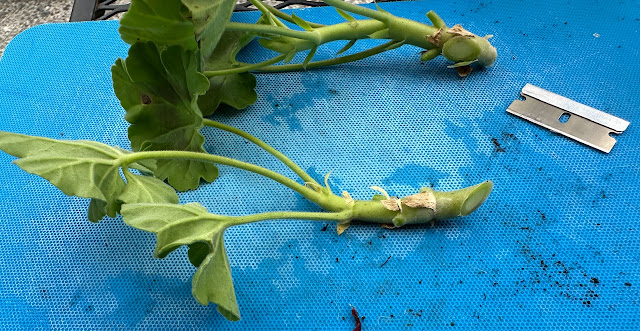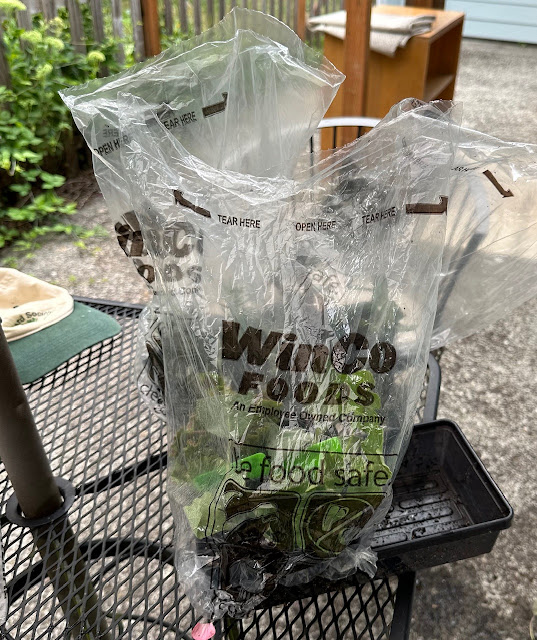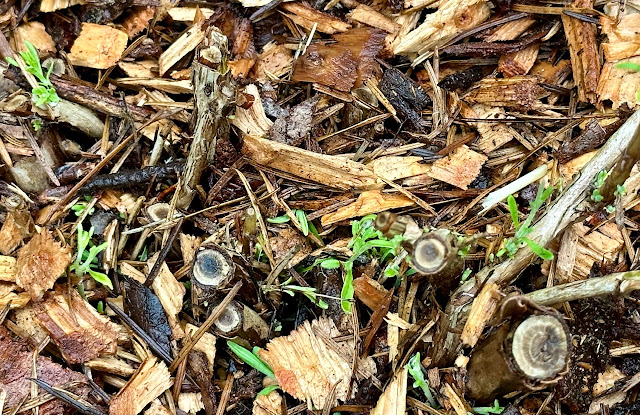These were overwintered from last year.
Tuesday, August 20, 2024
Pink Mandevilla Update. Thrived After Rehab. 20 Aug 24.
This is the two- or three- year old Mandevilla vine that I overwintered. In April, I pruned severely and repotted in fresh potting soil. info 20 Apr 24.
It took a while for full comeback. That was a severe rehab. Here it is now.
Pretty dramatic comeback.
I can't recall what I did previous years. This time I used a dilute balanced fertilizer until it leafed out, then occasional dilute bloom food. No high nitrogen - I don't want long vines this time.
Late Summer Cuttings. Geranium, Spanish Lavender, Sage, Rosemary. 20 Aug 24.
There are several plants in the border that I think I'd like to propagate for planting next Spring. If they root, I can keep them in sheltered location or in the Sunroom during cold winter weather.
I tried sage, Rosemary, and geraniums in water over the past few weeks. Not doing well, which might be the season or other factors. Sometimes it works for me for geraniums. I've seen on line that water works for rosemary and sage. One geranium cutting grew a root and is in soil now.
I didn't have more sage, so trimmed the cuttings in water back to fresh tissue. I did that for the rosemary too.
My cutting materials before trimming.
With the sage, I want fresh clean cuts in fresh tissue. Also, the leaves might transpire too much, so I trimmed them.
Sage cutting, before trimming. I used single edge razor blade for the sharpest, cleanest cuts.
Then I used a butter knife as a dibbler, made a hole in pre-wetted seed starting medium, and inserted about two nodes deep.
Cleanup of the rosemary cuttings was similar. Before and after trimming, same photo.
I also cut the apical growth. I don't know if that makes a difference.
The geranium cuttings. Before trimming.
After trimming.
Treatment of Spanish lavender cuttings was similar to the rosemary, except they were freshly harvested.
All planted.
Then I placed the pots of cuttings into produce bags. Four fit per bag.
I'm keeping them on the North side of the garden shed, out of the sun, Current temp is 70F.
Will they root and grow? I'll be watching them.
Thursday, August 15, 2024
Extreme Pruning of Lavender Bush. 15 Aug 24.
Still doing rehab of the border.
When I first planted the border, I moved some lavender plants there that had been in a wildflower meadow. I don't know the cultivar. They survived and grew, but during the past two years I was unable to care for the border. It was taken over, mainly by thistles.
Two of those lavender plants survived but were so scraggly and woody, I didn't think they could be rehabilitated. So I cut them off.
That was a week ago. Today I noticed there were multiple buds growing from the bases.
Wednesday, August 14, 2024
An Experiment: Will Girdling Speed Up Fall Fig Ripening? 14 Aug 24.
I recall a rule of thumb, it takes about 100 days for a fig bud to ripen into a full fledge, ripe fig. So from now, that would be about 14 Nov.
It's possible weather will be good until then. It's also possible, and more likely, there will chill and rain. Those conditions cause ripening figs to mold, and we lost the crop.
My biggest disappointments for fall ripening are Brunswick, Petite negri, and Smith. They are all excellent figs, but ripen so late that a get very few before they mold from the rain and chill.
I decided to do some experiments.
First, girdling. I noticed that the Petite negri air layer grew about four feet above the girdling. That tree grows very slowly, about a foot to 18 inches a year. I wondered about that. The leaves are also much larger. I think the difference is due to the fact that the leaves, which are the trees solar collectors, make carbohydrates that transport to the roots. Girdling removes the phloem layer, and stops that transport. So the carbohydrates remain in the stem, and in the case of the air layer, make top growth and new roots.
There are also hormonal effects that I don't know.
For fig production, the effect might be similar. Except instead of producing top growth and more leaves, or roots, the carbohydrates go into the growing figs. Possibly, removing the growing tip, would also help. I do that anyway. And removing any tiny fig buds that don't have time to grow and ripen,
First step. Removing a strip of bark (girdling). I used a single edge razor blade, and pushed it into the bark. Then around, sort of like a copper pipe cutter. Then must peel off that section of bark.
I did this on Brunswick fig. Also Petite negri. There was a fork, somI left one side without girdling, for a comparison.
I don't know if this will cause the inner wood to dry out too much. I wrapped tape on some. Most, I just tried to remove a narrow strip of bark to minimize potential drying effect.
I also tipped the ends to remove the growing tips, and removed the fig buds above the fairly large figs. To do that, I just bent the buds until they snapped off.
Below, snapping the growing tip.
Below, snapping of fig buds.
Will all of this help? Time will tell.
I did this for Petite negri, Smith, and mostly Brunswick.
This experiment suggests it might work, but I don't have any good details, so had to make it up as I went along.




















